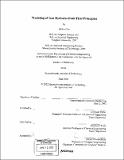| dc.contributor.advisor | Jefferson Tester and Bernhardt Trout. | en_US |
| dc.contributor.author | Cao, Zhitao, 1974- | en_US |
| dc.contributor.other | Massachusetts Institute of Technology. Dept. of Chemical Engineering. | en_US |
| dc.date.accessioned | 2005-08-23T20:37:16Z | |
| dc.date.available | 2005-08-23T20:37:16Z | |
| dc.date.copyright | 2002 | en_US |
| dc.date.issued | 2002 | en_US |
| dc.identifier.uri | http://hdl.handle.net/1721.1/8496 | |
| dc.description | Thesis (Ph.D.)--Massachusetts Institute of Technology, Dept. of Chemical Engineering, 2002. | en_US |
| dc.description | Includes bibliographical references. | en_US |
| dc.description.abstract | Ab initio calculations were used to determine the H20-CH4 potential energy surface (PES) accurately for use in modeling gas hydrates. Electron correlation was found to be treated accurately by the second-order Moller-Plesset method (MP2). However, a large basis set, cc-pVQZ, was found to be necessary in order to compute the binding energies to within 0.1 kcal/mol of the basis set limit. In order to sample accurately the PES, the H2O-CH4 energy of interaction was computed at 18,000 points. For these computations to be feasible, a new method was developed in which all 18,000 points were computed using MP2/6-3 1++G(2d,2p) and then corrected to near the accuracy of MP2/cc-pVQZ. The PES calculated from the six-dimensional numerical potential agrees very well with far infrared vibration-rotation-tunneling spectroscopic data and experimental second virial coefficient data at the potential minimum and larger separations. In order to study the application of different potential forms to describe phase equilibrium for Structure I gas hydrates, molecular computations were performed and results were compared. Although simple potential forms can be fit satisfactorily to experimental P-T data for ethane and cyclopropane hydrates using the van der Waals and Platteeuw model, they fail to predict accurately cage occupancies of methane hydrates. Predicted phase equilibria and cage occupancies for methane hydrates using the ab initio potential are in close agreement with experimental P-T data and measured cage occupancies. The comparison showed that only the first-principles ab initio potential is able to physically characterize both the microscopic and macroscopic behaviors of methane hydrates. | en_US |
| dc.description.abstract | (cont.) Various sets of thermodynamic reference properties currently available in the literature were examined by applying the van der Waals and Platteeuw model to predict monovariant 3-phase equilibria for hydrate forming binary mixtures from 260 to 320 K. Experimental uncertainties were found to be large enough to cause significant changes in the prediction of dissociation pressures. The ab initio methane-water intermolecular potential was used to obtain the reference properties with significantly small deviations, and the resulting parameters are able to give the best prediction of phase equilibria over the entire temperature range. | en_US |
| dc.description.statementofresponsibility | by Zhitao Cao. | en_US |
| dc.format.extent | 196 leaves | en_US |
| dc.format.extent | 12856582 bytes | |
| dc.format.extent | 12856338 bytes | |
| dc.format.mimetype | application/pdf | |
| dc.format.mimetype | application/pdf | |
| dc.language.iso | eng | en_US |
| dc.publisher | Massachusetts Institute of Technology | en_US |
| dc.rights | M.I.T. theses are protected by copyright. They may be viewed from this source for any purpose, but reproduction or distribution in any format is prohibited without written permission. See provided URL for inquiries about permission. | en_US |
| dc.rights.uri | http://dspace.mit.edu/handle/1721.1/7582 | |
| dc.subject | Chemical Engineering. | en_US |
| dc.title | Modeling of gas hydrates from first principles | en_US |
| dc.type | Thesis | en_US |
| dc.description.degree | Ph.D. | en_US |
| dc.contributor.department | Massachusetts Institute of Technology. Department of Chemical Engineering | |
| dc.identifier.oclc | 50763160 | en_US |
